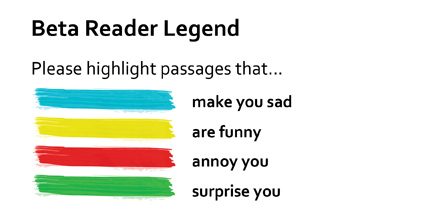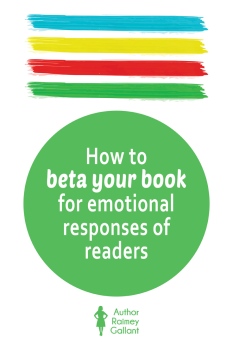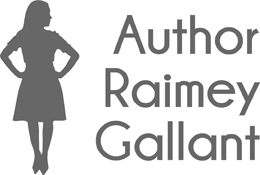
Test screening is to films what beta reading is to books. In film, studies are being done on technology that can gauge a test screen audience’s neuro and biometric responses. Suffice it to say, when this technology proves viable, I will not be able to afford it. But that doesn’t mean that I don’t want a way to know which parts of my books make people laugh, cry, or want to throw their e-reader against the wall.
After I wrote my first book, I had a desperate yearning to find out if it was as funny as I thought it was, so I came up with a rudimentary DIY method for attaining similar results to what scientists are trying to achieve for the film industry. Here’s what I did:

I gave three of my betas the above legend and asked them to highlight passages that gave them more extreme emotional responses. This is more work for betas, so make it as easy  as possible for them. If they prefer an electronic copy, put the legend in a separate document from the manuscript so they can toggle back and forth. If hard copies are their jam, give them physical highlighters and a printed legend.
as possible for them. If they prefer an electronic copy, put the legend in a separate document from the manuscript so they can toggle back and forth. If hard copies are their jam, give them physical highlighters and a printed legend.
Your results will never be as unbiased as those possible with a major film studio’s test screening, but if you try to find beta readers with little to no vested interest in your emotional well being (not family, not friends), the viability of your results will be better.
Have you ever used beta readers? What’s your process like? Please share in the comments.
This post is part of the #AuthorToolboxBlogHop. So many great blogs to keep hopping through. Click here to join the hop and to see what other writing tips you can glean from this month’s edition.


I like the color-coding idea. I’ll use that next time. Yes, I have test readers who see a manuscript first, then after more polishing, I use critiqu partners.
LikeLiked by 1 person
Thanks, Alex. I hope it works out well for you.
LikeLike
That’s a great idea, Raimey. I’m RT this.
LikeLiked by 1 person
Merci, Jacqui! Will be hopping over to your blog soon!
LikeLike
That does seem like a strong idea. Among other things, it gives audiences more license to respond without having to compose their words. As the author you’ve already given them a simple system, and encouraged them to make remarks, both positive and negative.
In the past I’ve tried to only provide a general statement of “this is intended for publication” and “I’m trying to keep it within this word count range”, but otherwise I favor letting audiences initially provide whatever feedback they choose. Once they’ve responded with their own thoughts, I like to do a second round of either live back and forth discussion, or specific questions.
But I think your idea might also make for a strong first round of feedback. The only thing I might change would be to either change one of them, or add a fifth, so that there was more than 1 “negative color”, to provide audiences with greater flexibility. I think I’d be tempted to add “bored” or “uninterested” as a fifth possibility, though that might in turn prompt revising “annoyed” to represent some form of “confused” or “overwhelmed”. It’s definitely an interesting technique.
In some ways it reminds me of something I do with my own editing process. I will map out the story, using simple labels like “ch01” to represent each segment, and then I will color code the different characters based on the level of tension, and whether the tension is rising or falling. It gives me a nice visual of when and how the story is progressing, without necessarily referencing any of the concrete details.
Ironically, I think it’s very easy to put excess emphasis on the words in the story, and overlook the more abstract levels of the experience.
Thank you for sharing. This is definitely an interesting idea.
LikeLiked by 1 person
Thanks, Adam! You’re right about there being more than one way to execute this idea.
LikeLiked by 1 person
While I haven’t had anyone beta my own work (not ready for that yet), I have done a couple of beta reads for other people. I had never thought of this method regarding emotional responses. If I’m asked to do another, I ‘ll need to keep this in mind.
LikeLiked by 1 person
Sounds good. 🙂
LikeLike
This is a great system. I think I’ll use it when I get around to sharing with others on my master’s degree 🙂
We get the most out of beta readers when we ask the right questions, and whilst I’ve never had a beta myself, I’ve read others work. I love it when they include a checklist.
LikeLiked by 1 person
Checklists are great, too. A combination of the two systems could work, as well.
LikeLiked by 1 person
I like the color coding. So many creative people love visual questions like this. Thank you 🙂
LikeLiked by 1 person
My pleasure. That’s a great point that this might be a better approach for visual people.
LikeLiked by 1 person
I did a Margie Lawson immersion class and she teaches color coding for all responses. Its a good way to work out plot holes and story holes/
LikeLiked by 1 person
I’m going to go and google that right now! Thanks!
LikeLike
I hope you found it. She gets lot of publicity as her graduates are constantly in the bestseller lists.
LikeLike
I have used betas for several works and discover two things: not everyone agrees and reading one documents (all the feedback merged) was easier on me. I don’t know if it would work with the highlighted passages, but it might if my first rule was true for your readers as well. 🙂
Anna from elements of emaginette
LikeLiked by 1 person
It could work to merge highlights of multiple readers. I just looked at them side-by-side, but it depends how many readers you have. 🙂
LikeLiked by 1 person
What a great idea. Love the legend for the visual look.
LikeLiked by 1 person
Thanks, Juneta. Feel free to use it. 🙂
LikeLike
I love this idea. I’m always trying to get better feedback from my beta readers. This is simple enough for the non-writer, but would still lend helpful results. Thanks for sharing
LikeLiked by 1 person
My pleasure. Like others are saying, it might work well for some authors if it’s combined with a worksheet or an additional step of going back for feedback after the color-coding is received.
LikeLike
I really like this idea! Very straightforward way to learn how your writing is perceived by a diverse audience. I’m also a sucker for anything involving color-coding. 🙂
LikeLike
Interesting! I never really thought about color coding, but it makes sense. I think I’m mostly desperate for anything beta readers are willing to give me.
LikeLiked by 1 person
Same. 🙂
LikeLike
Omg I love this. What a great idea! I’ll def keep this in mind for my next book… Thanks for sharing!
LikeLiked by 1 person
My absolute pleasure. 🙂
LikeLike
I love the color coding idea for beta readers. Some of us used to do something similar in law school when briefing cases, with a different color for issue, rationale, analysis, and conclusion. There’s something scientific about the visual cues, but I am resisting the urge to Google it and get lost in an hour of “research.” 🙂
LikeLiked by 1 person
Lol, I feel you. What an interesting factoid. Thanks for that, Lee.
LikeLike
At first the color coding idea startled me because I imagined it would be a ton of extra work and it’s hard enough getting beta readers in the first place! Then I thought about it more, and this could actually reduce the work. If my beta readers don’t feel like writing out an exhaustive point-by-point critique, they could just highlight using the color code and move on. Simple, and easy. There’s nothing to say they have to do both, leave comments and highlight. They could pick whichever is easier for them. This is an excellent idea, thanks Raimey!
LikeLiked by 2 people
I like the idea of letting them decide whatever is easiest a lot. 🙂
LikeLiked by 2 people
This is a great idea! I never actually thought of directly asking beta readers to let me know where they experience an emotional reaction. Usually when I beta read, I insert things like that in a comment. Even if the comment is just “LOL!” I know it’s fun for the writer to see comments like that. 🙂
LikeLiked by 1 person
I love it when my CPs do that, too. 🙂
LikeLike
I’ve done something similar for my own editing. This is a great idea if you can convince your beta readers to do a little extra work.
LikeLiked by 1 person
Great minds… 😉
LikeLike
Great idea. I think it’s definitely helpful to give beta readers some guidance on what to look for. And emotional response is really important to know.
LikeLiked by 1 person
Thanks, Tim!
LikeLike
Love this. This is a great way for a beta reader to know what you need from them!
LikeLiked by 1 person
Merci, Kristina!
LikeLiked by 1 person
I LOVE creativity! So great job at creating your own DIY for beta readers. Would you share how you used that DIY beta test results to edit your book?
LikeLiked by 1 person
Let me think. It was a long time ago. 😉 What I was interested in most at the time was whether I was actually able to jiggle anyone’s funny bone, so I went back through my jokes/humor that didn’t receive an emotional response, and those were the ones I looked at revising.
LikeLike
Wow, I never even thought about doing this. A simple but brilliant idea. I think this would actually be easier for some readers because it means they’re able to highlight rather than explain a section. As long as they know how to highlight of course. Totally using this for my latest MS which is almost ready for beta’s scrutiny (one of my favourite parts of the writing process). X
LikeLiked by 1 person
It might help keep a reader’s flow going, as well.
LikeLike
What a terrific idea. I will bear it in mind for the future.🌼
LikeLiked by 1 person
So happy you like it. 🙂
LikeLiked by 1 person
I never thought to ask someone ELSE to color code my manuscript. Thanks, Raimey! I’ve personally color coded the manuscripts to see how many times a certain child is mentioned in the ms. Have a great weekend!
LikeLiked by 1 person
It worked for my purposes. 🙂
LikeLike
This is such a great idea! I’m close to have my MS ready for Beta Readers and I was wondering what systems to use! Thanks for sharing!
LikeLiked by 1 person
My pleasure. Good luck!
LikeLiked by 1 person
Ty!!!
LikeLike
I love this idea!!!! 💕
I plan on gathering a beta readers group next week and love this color coded method!
LikeLiked by 1 person
I’m so happy you like it. 🙂
LikeLiked by 1 person
It is a great way to get more specific backfeed!
LikeLiked by 1 person
This is a great idea. I asked the alpha readers for my upcoming release to do something similar, but only had them mark their copies of the manuscript with pen. I love the color-coding aspect. It adds a bit of fun and makes for quick scanning.
LikeLiked by 1 person
It does make it sound more fun 🙂
LikeLike
I love color coding. My Scrivener chapters use color coded tabs for different POVs. I’ve used different highlighters while editing to make sure I have enough emotional angst, setting, internal thoughts, etc. I think color coding from your beta readers is a great idea.
LikeLiked by 1 person